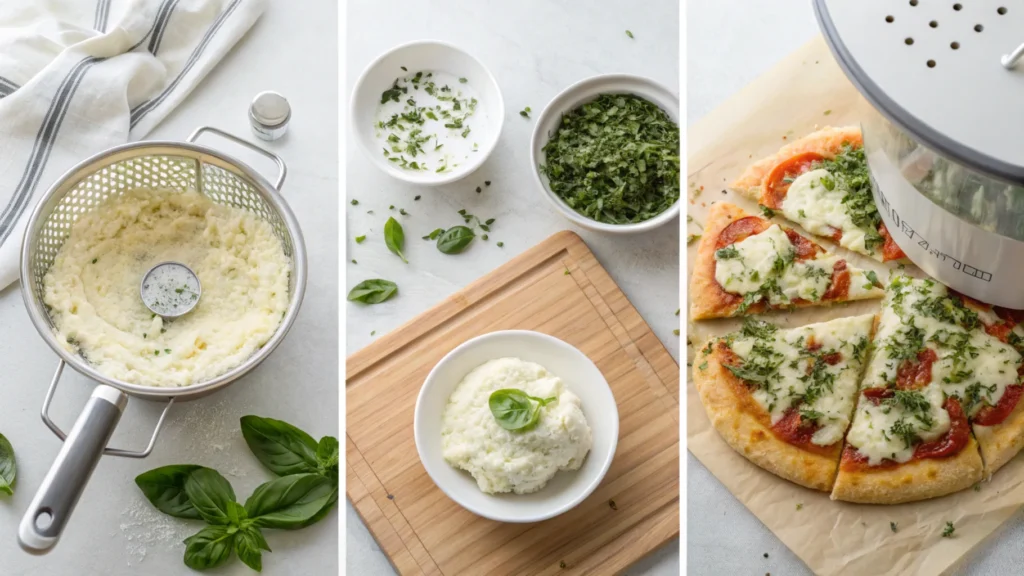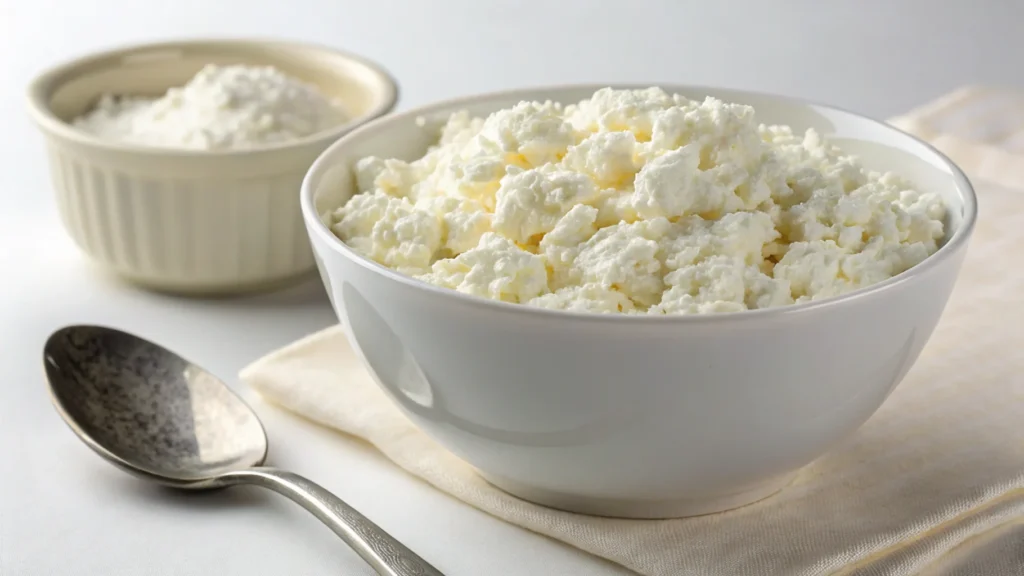When you’re making pizza and run out of ricotta, you might wonder, Can cottage cheese be substituted for ricotta on pizza? The answer is a resounding yes! But hold on—it’s not always a straight swap. Cottage cheese can be an excellent alternative, but there are a few tricks to make it work seamlessly. In this article, we’ll explore the differences between these two cheeses, why substitution matters, and how to make the best pizza using this versatile ingredient. Let’s dive in!
Table of contents
- Understanding Cottage Cheese and Ricotta
- The Case for Cottage Cheese on Pizza
- Best Practices for Substituting Cottage Cheese
- Creative Recipes Using Cottage Cheese Instead of Ricotta
- Nutritional Comparison: Cottage Cheese vs. Ricotta
- Cooking Techniques for Cottage Cheese on Pizza
- Common Mistakes When Using Cottage Cheese as a Substitute
- Frequently Asked Questions
- Can Cottage Cheese Be Used for Other Ricotta-Based Dishes?
- Conclusion: Why Cottage Cheese Is a Great Substitute for Ricotta on Pizza

Understanding Cottage Cheese and Ricotta
What Makes Cottage Cheese and Ricotta Different?
Before diving into substitution techniques, it’s important to understand how cottage cheese and ricotta differ. While both are creamy and versatile, their textures and flavors set them apart:
- Texture: Ricotta is smoother and thicker, making it a natural fit for spreading or dolloping on pizza. On the other hand, cottage cheese has curds, which can feel a bit lumpy unless blended.
- Flavor: Ricotta has a mild, slightly sweet flavor, while cottage cheese has a tangier profile. This tanginess can add a unique twist to your pizza, depending on your taste preferences.
- Moisture Content: Ricotta tends to be denser, whereas cottage cheese has more liquid, which could affect your pizza’s consistency if not prepared correctly.
Despite these differences, cottage cheese can still mimic ricotta’s role with a few tweaks, which we’ll explore in later sections.
Why Substitution Matters
So, why would you substitute cottage cheese for ricotta on pizza? There are a few compelling reasons:
- Accessibility: Cottage cheese is often easier to find in stores and usually costs less than ricotta.
- Health Benefits: Cottage cheese is lower in fat and calories, making it a healthier alternative for those watching their diet.
- Experimentation: If you’re looking to add a tangy edge to your pizza, cottage cheese is worth a try.
In short, the question Can cottage cheese be substituted for ricotta on pizza? is about more than convenience—it’s about creating a dish that’s both delicious and suited to your needs.
The Case for Cottage Cheese on Pizza
Benefits of Using Cottage Cheese as a Substitute
When considering the question, Can cottage cheese be substituted for ricotta on pizza?, the benefits are hard to ignore. Cottage cheese brings several advantages to the table, making it a worthy alternative:
- Healthier Option: Cottage cheese is lower in calories and fat compared to ricotta, which makes it a great choice for those watching their diet. Plus, it’s packed with protein, offering a nutritional boost.
- Affordable and Accessible: Cottage cheese is widely available in most grocery stores and often costs less than ricotta. This accessibility makes it a practical choice when you need a quick substitute.
- Versatility: Its tangy flavor adds a unique twist to traditional pizza recipes, while its creamy texture can be adjusted with blending to suit your needs.
These benefits make cottage cheese an excellent option for experimenting with different pizza styles, whether you’re aiming for a healthier version or a bold flavor profile.
Common Concerns and How to Address Them
While cottage cheese is a fantastic alternative, some common concerns may arise. Here’s how to address them effectively:
- Excess Moisture: One of the primary worries is whether cottage cheese will make the pizza soggy. To solve this, drain the cheese in a fine mesh strainer or cheesecloth to remove extra liquid.
- Lumpy Texture: Unlike ricotta, cottage cheese has noticeable curds. Blending it in a food processor creates a smoother, ricotta-like consistency.
- Flavor Adjustment: Some might find the tanginess of cottage cheese overpowering. To balance this, mix in a pinch of salt, garlic powder, or Italian herbs for a flavor closer to ricotta.
By addressing these concerns, you’ll ensure a seamless substitution that enhances your pizza without compromising quality.
Best Practices for Substituting Cottage Cheese
Tips for Preparing Cottage Cheese for Pizza
To make the substitution successful, preparation is key. Here are a few tips to get the most out of cottage cheese as a ricotta replacement:
- Drain Thoroughly: Excess moisture can ruin the texture of your pizza. Use a cheesecloth or strainer to remove as much liquid as possible.
- Blend for Smoothness: For a creamy, spreadable texture similar to ricotta, blend the drained cottage cheese in a food processor. This step is especially important if you want the cheese to mix well with other toppings.
- Season to Taste: Adding herbs like basil, oregano, or thyme can help mimic ricotta’s flavor. A dash of garlic powder or parmesan cheese can also enhance the overall taste.
Pairing Cottage Cheese with Complementary Ingredients
Cottage cheese has a tangy flavor that pairs beautifully with certain toppings. When you’re exploring Can cottage cheese be substituted for ricotta on pizza?, consider these combinations:
- Vegetable Toppings: Roasted zucchini, spinach, or cherry tomatoes work well with cottage cheese.
- Herbs and Spices: Sprinkle fresh basil, crushed red pepper, or thyme to elevate the taste.
- Protein Options: Grilled chicken or turkey sausage complements the tanginess of the cheese.
By pairing cottage cheese with complementary ingredients, you can create a pizza that’s not only delicious but also unique.
Creative Recipes Using Cottage Cheese Instead of Ricotta
Classic White Pizza with Cottage Cheese
Can cottage cheese be substituted for ricotta on pizza? Absolutely! One of the most delicious ways to enjoy this substitution is by crafting a classic white pizza. Instead of traditional tomato sauce, spread a creamy layer of blended cottage cheese over the crust. Add sautéed spinach, minced garlic, and shredded mozzarella for a rich, flavorful topping.
Bake the pizza at 375°F (190°C) until the crust is golden and the cheese is bubbling. The result is a tangy, creamy white pizza that rivals any ricotta-based recipe. It’s proof that cottage cheese can elevate your pizza game with ease.
Vegetarian Delight with Fresh Vegetables
For a lighter, veggie-packed option, use cottage cheese as the base for a vegetarian pizza. Spread it generously over your crust and layer it with roasted zucchini, cherry tomatoes, and sliced bell peppers. Sprinkle some oregano and crushed red pepper flakes for an extra kick.
This recipe not only highlights the versatility of cottage cheese but also pairs it with fresh, wholesome ingredients. For more ideas, check out the Cottage Cheese Pizza Crust Recipe for inspiration.

Nutritional Comparison: Cottage Cheese vs. Ricotta
Calorie and Fat Content
When asking Can cottage cheese be substituted for ricotta on pizza?, the nutritional benefits are a key factor. Cottage cheese is significantly lower in calories and fat compared to ricotta, making it an excellent choice for health-conscious eaters. A half-cup serving of cottage cheese typically contains about 100 calories and 2 grams of fat, while ricotta often doubles these numbers.
Protein and Nutritional Value
Cottage cheese is also higher in protein, offering about 12 grams per serving compared to ricotta’s 6 grams. This makes it ideal for those on high-protein diets or looking to build muscle. Additionally, cottage cheese is rich in calcium and B vitamins, supporting bone health and energy metabolism.
Which Cheese Is Better for Weight Loss?
If your goal is weight management, cottage cheese is the clear winner. Its lower calorie count and higher protein content help keep you full longer, making it easier to avoid overeating. Plus, its tangy flavor allows you to use smaller amounts while still delivering big taste.
Cooking Techniques for Cottage Cheese on Pizza
Baking Tips for a Perfect Pizza
When exploring Can cottage cheese be substituted for ricotta on pizza?, the cooking process plays a big role in ensuring a successful result. Baking is the most popular method, and it’s relatively simple with the right techniques.
- Preheat Your Oven: Set your oven to 375°F (190°C). A properly preheated oven ensures even cooking and prevents soggy crusts.
- Prepare the Cheese: Always drain and blend your cottage cheese before using it. This step prevents excess moisture and creates a creamy texture that spreads easily.
- Add Toppings Strategically: To avoid overloading the pizza, layer your toppings lightly. For instance, place vegetables like spinach or zucchini first, then dollop the cheese over them for a balanced finish.
By following these steps, you’ll achieve a pizza that’s both crispy and flavorful, making the most of your cottage cheese substitution.
Grilling and Air-Frying Options
If you’re feeling adventurous, grilling or air-frying can offer unique flavors and textures.
- Grilling: Preheat your grill to medium heat and use a pizza stone or a grill mat. Grilling adds a smoky flavor that complements the tanginess of cottage cheese. Keep an eye on it to prevent burning.
- Air-Frying: Preheat your air fryer to 375°F (190°C) and place the pizza inside on parchment paper. Cook for 8–10 minutes or until the crust is golden and crispy. This method is quick and creates an irresistible crunch.
These alternative methods not only enhance the flavor but also add variety to your pizza-making adventures.

Common Mistakes When Using Cottage Cheese as a Substitute
Using Too Much Cheese
A common mistake when asking Can cottage cheese be substituted for ricotta on pizza? is using too much of it. While it’s tempting to add a generous layer, excess cottage cheese can make the pizza overly moist. To avoid this, use about 1/2 cup for a medium-sized pizza. Additionally, spread the cheese evenly for consistent flavor and texture.
Skipping the Blending Step
Another frequent error is skipping the step of blending the cottage cheese. Its natural curds can result in a lumpy texture that doesn’t spread well. By blending, you achieve a smooth consistency similar to ricotta, making it easier to integrate with other toppings.
If you don’t have a blender, a whisk or fork can also help break down the curds. Taking this small step ensures your pizza has the creamy texture you’re aiming for.
Not Draining Excess Moisture
Cottage cheese has a higher moisture content than ricotta, which can lead to a soggy crust if not properly drained. Use a cheesecloth or a fine mesh strainer to remove the extra liquid before blending. This simple step makes a huge difference in the final result.
Frequently Asked Questions
Does Cottage Cheese Work the Same as Ricotta on Pizza?
The question Can cottage cheese be substituted for ricotta on pizza? often leads to concerns about whether it performs the same way. While cottage cheese doesn’t have the exact texture of ricotta, it’s surprisingly effective with a few adjustments. For instance, blending cottage cheese creates a smooth consistency that closely mimics ricotta’s creamy texture.
However, it’s important to note that cottage cheese has a tangier flavor. To balance this, you can mix in a pinch of salt or other seasonings. When used correctly, cottage cheese can rival ricotta in both taste and functionality on pizza.
What Adjustments Are Needed When Substituting?
To ensure a successful swap, certain adjustments are necessary:
- Draining Excess Moisture: Cottage cheese contains more liquid than ricotta, so draining it thoroughly is key. A cheesecloth or strainer works well for this step.
- Blending for Smoothness: If you prefer a seamless, spreadable layer, blending the cheese is a must. This not only improves the texture but also helps it integrate better with other toppings.
- Seasoning the Cheese: Ricotta has a milder flavor compared to cottage cheese. Adding garlic, basil, or oregano can help bridge this gap and bring the flavors closer together.
By addressing these adjustments, you’ll achieve a result that’s nearly indistinguishable from ricotta.

Can Cottage Cheese Be Used for Other Ricotta-Based Dishes?
Beyond Pizza: Expanding Cottage Cheese Substitutions
The question Can cottage cheese be substituted for ricotta on pizza? opens up possibilities for other dishes as well. Cottage cheese works wonderfully in recipes like lasagna, stuffed shells, or even ravioli. Just like on pizza, blending and seasoning are key steps to ensure the right consistency and flavor.
For example, in lasagna, blended cottage cheese layers seamlessly between noodles and sauce. Similarly, in stuffed shells, its tangy taste adds a fresh twist to traditional ricotta-based fillings.
Are There Any Limitations to Using Cottage Cheese?
While cottage cheese is a versatile substitute, it does have its limitations. For instance:
- It may not hold its shape as well as ricotta in baked dishes, due to its higher moisture content.
- The tangy flavor might not suit sweeter recipes like desserts or pastries, where ricotta’s mildness is a better fit.
Despite these minor drawbacks, cottage cheese remains a highly adaptable ingredient, especially for savory dishes.
Conclusion: Why Cottage Cheese Is a Great Substitute for Ricotta on Pizza
The question Can cottage cheese be substituted for ricotta on pizza? opens the door to creative and healthier cooking options using cottage cheese. With a few simple techniques, you can easily substitute cottage cheese for ricotta and achieve a creamy, delicious result. Not only does this alternative offer a tangy flavor and smooth texture, but it’s also lower in fat and calories, making it a perfect choice for health-conscious eaters.
When you substitute cottage cheese for ricotta, the key is preparation. Draining the excess moisture, blending for smoothness, and adding the right seasonings can transform it into a perfect match for pizza and other ricotta-based dishes. Whether it’s a white pizza, a vegetable-packed creation, or even lasagna, substituting cottage cheese for ricotta adds a unique twist while maintaining the dish’s integrity.
So, why not give it a try? The next time you’re out of ricotta or want to explore a lighter option, confidently substitute cottage cheese for ricotta and let it shine as a versatile and flavorful ingredient. Remember, when you substitute cottage cheese for ricotta, you’re not just saving time and money—you’re also making a choice that supports healthier, creative cooking.

